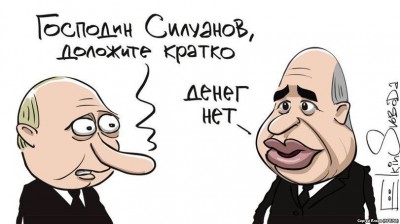
The Central Bank intends to dedollarizing banking system. About it February 11, said Elvira Nabiullina. De-dollarization should relate to currency deposits and funds of enterprises. The Central Bank will gradually apply measures that will encourage the reduction of foreign currency assets and liabilities of banks. The Central Bank is concerned about the fact that the company receiving proceeds in rubles, in dollars. In case of further falling ruble it can increase debt burden and pose a systemic risk to the entire economy.
Currency mortgage holders will be all country. The regulator proposes to establish increased coverage ratios capital for foreign currency loans. For all loans and securities in foreign currency, except for loans to subjects of the Russian Federation, may be introduced multiplying factor of 1.1 for the roofing requirements for capital. Real estate can be set a factor of 1.3. Securities of non-residents is 1.5.
In 2015, the volume of deposits of individuals increased 2.2 times. While the increase in the share of foreign currency deposits of total deposits in various banks amounted to 8-10 PPT the Share of foreign currency deposits increased to 30-60%. This is due to the fact that the people “ran” from inflation and devaluation in foreign currency. Not all banks the increase in foreign currency liabilities beneficial. Accumulated currency must be translated into assets — that is, lending to people and businesses. If in future the ruble weakens critically, borrowers may experience the same problems as now with currency food. Some banks not engaged in foreign currency lending and deposits accumulated on the currency used for the payment of their debts. But the conversion obtained from banks deposits foreign currency in rubles in large quantities can be risky. In the event of a sharp outflow of deposits combined with a devaluation, banks will find it difficult to meet their obligations to depositors.
The willingness of enterprises to borrow in dollars and euros, even if their revenues are generated in rubles, demonstrates how unmanageable for the firms are interest rates on ruble loans. Despite the specter of a looming devaluation, manufacturers still dare to borrow in foreign currency.
WHAT IS THERE TO ADMIRE?
Some bloggers that I learnt of the intentions of the Central Bank in Patriotic colors. Actually, the intended operation is quite a technical exercise, not change anything systemically and not worth the hype which she tried to impart some commentators. You should understand the following.
Firstly, we are not talking about the transition to a new monetary strategy. Before the crisis the issue of the Central Bank was limited to the amount of money needed to buy back the excess currency from the domestic market. This essentially meant that the observance of Russia’s currency board — that is, the binding of rouble to the dollar. During the current crisis, the Central Bank has begun refinancing, however, barely visible scales. At the moment of emission the Central Bank is only enough to maintain the money supply relative to GDP. To change the model of monetary policy, which could be perceived as de-dollarization, is not expected.
Secondly, under the proposed de-dollarization does not imply the refusal from using dollars in foreign trade of Russia. A popular proposal among Liberalno minded professionals is a trading Russian energy resources for rubles. This would cause the demand for the Russian currency and increase its use in international trade. Russian residents would not need to exchange rubles for foreign currency at a galloping rate, to acquire a foreign asset. This could be done for rubles. Such a model has advantages, however also generates risks. To the inner contour of the cash flow is added largely related external, and the authorities becomes more difficult to regulate the monetary and financial processes. The feasibility of promotion of the ruble as the currency of international exchange deserves a separate discussion. We note only that in the initiative of the Central Bank on dedollarization is not contained.
Thirdly, the Central Bank does not intend to dedollarizing the economy as a whole. He’s just trying to do it with the banking system. And not completely get rid of dollars, and only partially relieve currency Bank account.
RISKS
Implementation of any event of this scale is fraught with risks, especially if the performance is not up to par.
The obvious risk for the population. For simple human actions of the Central Bank look like an insult. First staged devaluation and practically drove people in monetary savings. Now will these savings squeeze.
If people start taking the dollars out of banks and change them for rubles, it would support the Russian currency and slow down devaluation. But in respect of lending companies apply reverse logic. Now the producers take loans in dollars and exchange them for rubles. So they release excessive pressure from the ruble on the currency market. But if the Central Bank will reduce foreign currency lending, the supply of dollars on the foreign exchange market will cease and there will be the prospect of devaluation.
Basically, if two processes (reduction of foreign currency lending and the depreciation of the exchange savings) will occur at the same time, equilibrium in the foreign exchange market can be saved. Only here to reduce foreign currency savings of citizens seems more difficult. People are already concentrated their savings in banks, and to squeeze them out will be difficult. Against this background, received from the Ministry of Finance initiative Deposit haircuts is starting to look particularly ominous. Whether it was planned to freeze some of the foreign currency savings of citizens?
IF YOU PLEASE TO
That the Ministry of Finance discusses financial bail-in, it became known in late may. This procedure involves conversion of requirements of creditors of the third turn in subordinated debt or equity from a Bank. In layman’s terms, Bank deposits confiscated, and their holders instead are awarded shares of the Bank. Bank in the verge of bankruptcy! Withdrawn funds are used to close the hole in the Bank.
Thus the Ministry of Finance would like to save the Russian banks, on the verge of bankruptcy. Bail-in is typically used in relation to legal persons. But the Finance Ministry is not averse to extending this mechanism to wealthy individuals. At the moment, as an alternative considers the sum of 100 million rubles and more. And then, inevitably, will reduce this threshold. Once Gaydar just blew people’s savings in the savings books, releasing pictures and changing their scale. Today is preparing something similar.
In 2013 the mechanism of bail-in was tried and tested in Cyprus. Then the funds of large depositors and creditors of the Bank of Cyprus, were forcibly transferred in its shares. The shareholders of Bank unexpectedly become holders of deposits over 100 thousand euros. Their money in the amount of 47,5% of deposits were used to rescue the sinking financial giant.
The Ministry of Finance was not the first who announced a proposal to launch a bail-in. Last year this topic has been discussed and the Agency for Deposit insurance (DIA) and the Central Bank.
CONCLUSION
Conceived by the global de-dollarization the Central Bank is unlikely to turn into a large-scale reorganization of the banking system. Most likely, the Central Bank will be able only to place some limits on foreign exchange turnover in the banking system. Still, in conditions of high instability of the ruble to force economic agents to get rid of dollar assets will be difficult.
There is also the inconsistency of the Central Bank. The impression is that again it focuses not on the challenges. Instead of promoting manufacturing, the Central Bank traditionally focuses on the fight against inflation. Instead of limiting speculation in the direct sphere of their occurrence in the currency market, the Central Bank chose to lift the discount rate and cut off from the real sector of credit resources.
Here and now, when I want to see the system work the CB to bring the country out of crisis (of course, together with other authorities), we see him trying to solve the problems of the economy at the expense of the real economy — consumers and producers. But in the liberal Constitution of 1993 and recorded: the Central Bank makes decisions independent of other public authorities. Ie, the concerns of the government of Russia not included in the list of concerns of the Central Bank. So it works either for their own profit, which contains (nonsense!), whether on advisors from the IMF, which since the times of Gaidar continue to “advise”.








